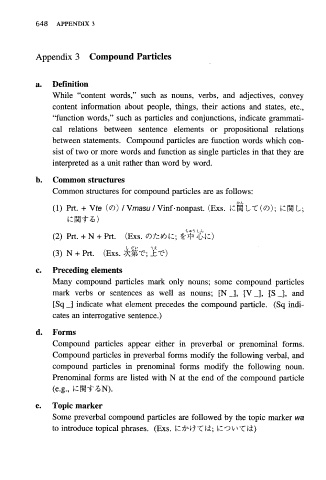Page 722 - Makino,Tsutusi.DictionaryOfIntermediateJGrammar
P. 722
648 APPENDIX 3
Appendix 3 Compound Particles
Definition
While "content words," such as nouns, verbs, and adjectives, convey
content information about people, things, their actions and states, etc.,
"function words," such as particles and conjunctions, indicate grammati-
cal relations between sentence elements or propositional relations
between statements. Compound particles are function words which con-
sist of two or more words and function as single particles in that they are
interpreted as a unit rather than word by word.
Common structures
Common structures for compound particles are as follows:
(1) Prt. + Vte (a)) / Vrnasu / Vinf.nonpast. (Exs. LT (a)); b:W L;
c:w-+a)
f*i LA
(2) Prt. + N + Prt. (Exs. a) 7: b 1:; Q @ L\K)
(3) N + Prt. (Exs. X&T; YT)
Preceding elements
Many compound particles mark only nouns; some compound particles
mark verbs or sentences as well as nouns; [NJ, [V -1, [S 1, and
[Sq _I indicate what element precedes the compound particle. (Sq indi-
cates an interrogative sentence.)
Forms
Compound particles appear either in preverbal or prenominal forms.
Compound particles in preverbal forms modify the following verbal, and
compound particles in prenominal forms modify the following noun.
Prenominal forms are listed with N at the end of the compound particle
(e.g., KW-FaN).
Topic marker
Some preverbal compound particles are followed by the topic marker wa
:
to introduce topical phrases. (Exs. b: i+ T kt; C 3 T 12)
lf
b

